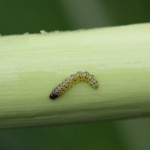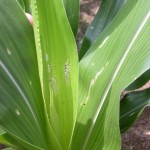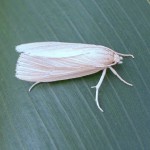Moth trapping data indicates the first generation moth flight is peaking (moth trap data). Although there are low numbers in most areas, there is some potential for infestations in non-Bt corn. We have new thresholds based on moth trap catches (see below), but I would encourage scouting whorl stage corn if moth traps in your area are averaging 20 or more moths per week.
New SWCB Thresholds: For non-Bt corn, treat prior to tasseling when 5 percent or more of plants are found with egg masses or live larvae or 7 to 10 days after pheromone traps catch an average of 50 or more moths on a seven-day catch. Beginning at tasseling (VT) and through the milk stage (R3), treat when 10 percent or more of plants are found with egg masses or live larvae or 7 to 10 days after pheromone traps catch an average of 100 or more moths on a seven-day catch. Treatment is generally not recommended once the dough stage (R4) is reached.
Scouting whorl-stage corn for southwestern or European corn borers is relatively easy. Small larvae feed in the whorl, and leaf feeding can be observed on the emerging leaves. Walk your non-Bt fields and look for feeding on emerging whorl leaves. Remove the whorl and unfurl it to confirm whether there is a larvae present and to make sure which species you are dealing with. Some pictures are included below. You may also find corn earworm or fall armyworm feeding in whorls, and this is of little concern unless infestation levels are very high. Please refer to previous articles about scouting southwestern corn borer (e.g., https://news.utcrops.com/2012/05/scouting-for-southwestern-corn-borer/).
There are a number of insecticides labeled for control of SWCB larvae, but I’ve had good success with pyrethroid insecticides such as Baythroid XL, Brigade, Karate/Warrior, and Mustang Max during the whorl stage. Once tasseling begins, I prefer products such as Belt, Besiege, Intrepid and Prevathon. A complete list of recommended insecticides and rates can be found in UT’s Insect Control Recommendations for Field Crops.





2 thoughts on “Southwestern Corn Borer and Corn”
Comments are closed.